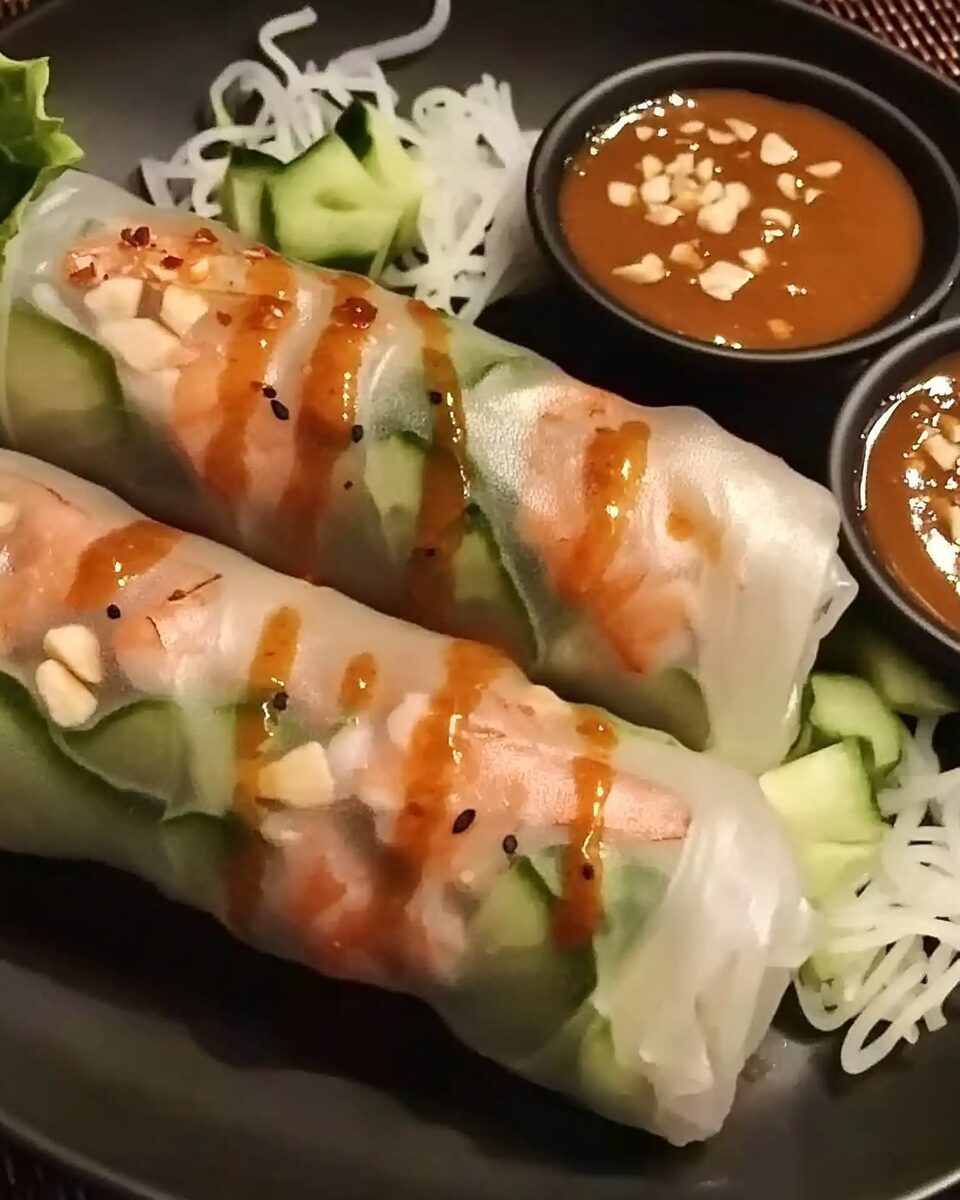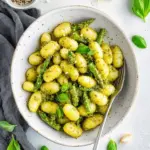These light, refreshing spring rolls are a classic Vietnamese appetizer, known as gỏi cuốn. Each roll features tender shrimp, slices of savory pork, vermicelli rice noodles, and a crisp mix of fresh herbs and lettuce, all wrapped in a soft, translucent rice paper. Unlike fried spring rolls, these are served fresh and cold, offering a healthy and vibrant bite with every roll.
Paired with flavorful homemade dipping sauces like a tangy hoisin-peanut sauce or a light fish sauce vinaigrette they make a perfect starter, snack, or light meal. Quick to prepare, fun to assemble, and endlessly customizable!
Full Recipe:
Ingredients:
-
Rice vermicelli noodles – cooked and cooled
-
Rice paper wrappers – softened in warm water
-
Cooked shrimp – halved lengthwise
-
Cooked pork slices (optional) – thinly sliced
-
Lettuce leaves – preferably soft varieties like butter lettuce
-
Fresh herbs – mint leaves, Thai basil, cilantro
-
Optional add-ins – shredded carrots, cucumber strips, daikon radish for extra crunch
Directions:
-
Prepare the Noodles:
Cook the rice vermicelli according to package instructions. Drain and rinse with cold water to cool. -
Prepare Fillings:
Slice cooked shrimp and pork thinly. Wash and dry lettuce and herbs. -
Soften the Rice Paper:
Fill a large bowl with warm water. Dip each rice paper sheet for about 5 seconds until pliable (not too soft it will continue to soften as you work). -
Assemble the Rolls:
Lay the softened rice paper flat. Near the bottom third, layer a small handful of noodles, a few shrimp halves, pork slices, lettuce, and herbs. -
Roll It Up:
Fold the sides inward, then roll tightly from the bottom up, like a burrito. -
Repeat:
Continue the process for all rolls. -
Serve with Dipping Sauce:
Serve immediately with homemade sauces like hoisin-peanut sauce or nuoc cham (fish sauce-based dip).
Prep Time: 35 minutes | Cooking Time: 5 minutes | Total Time: 40 minutes
Kcal: 134 kcal |Servings: 8 rolls (serving size: 1 roll)
Vietnamese Fresh Spring Rolls: A Classic, Refreshing Delight
Vietnamese cuisine is beloved around the world for its vibrant flavors, fresh ingredients, and beautiful balance between taste, texture, and nutrition. Among its most iconic dishes, Vietnamese Fresh Spring Rolls known locally as gỏi cuốn stand out as a symbol of health, community, and tradition. Light yet satisfying, these rolls are a refreshing contrast to heavier, fried appetizers. They have charmed diners globally with their delicate presentation and burst of fresh flavors. But beyond their deliciousness, these rolls carry a rich cultural story worth telling.
A Cultural Icon: The Roots of Gỏi Cuốn
Gỏi cuốn translates loosely to “salad rolls” in Vietnamese. They embody the Vietnamese culinary philosophy of balancing fresh and cooked elements, and combining textures—soft, chewy, crisp, and tender—in one elegant bite. Originally, these rolls were a way to make use of leftover ingredients and rice paper, turning simple household staples into a delicious and beautiful meal.
Traditionally enjoyed during gatherings and family meals, Vietnamese Fresh Spring Rolls highlight the country’s emphasis on communal eating. Every person customizes their own rolls at the table, choosing from a spread of proteins, herbs, and vegetables. This hands-on, build-your-own style of dining promotes interaction, laughter, and connection.
In Vietnam, spring rolls vary by region. In the south, they often include pork, shrimp, and a rainbow of herbs. In the north, versions may lean toward heartier flavors and different herbs based on availability and climate. This flexibility has allowed gỏi cuốn to adapt easily across generations and borders.
What Makes Vietnamese Fresh Spring Rolls Special?
At first glance, these rolls appear simple. However, their magic lies in the delicate balance of flavors and textures:
-
Freshness: Every bite bursts with the crispness of lettuce and herbs, balanced against the tender chew of noodles and proteins.
-
Lightness: Unlike fried spring rolls, gỏi cuốn are not greasy. They feel light and energizing, making them perfect for warm weather or as a starter before a larger meal.
-
Customizability: No two rolls have to be the same. They can be easily adapted for vegetarians, vegans, or those who prefer seafood, chicken, tofu, or even grilled beef.
-
Visual appeal: The translucent rice paper wrapper showcases the colorful ingredients inside, making each roll as beautiful as it is delicious.
The art of making a perfect spring roll lies in balancing the ratio of noodles to protein to herbs. Too much of any one element can overpower the others. When made thoughtfully, every component shines harmoniously.
The Role of Herbs and Dipping Sauces
One of the standout features of Vietnamese Fresh Spring Rolls is the generous use of herbs. In Vietnamese cuisine, herbs are not merely garnish they are essential to the flavor profile. Common herbs include:
-
Mint for brightness
-
Thai basil for a peppery bite
-
Cilantro for its aromatic punch
-
Chives for a mild onion flavor
These herbs contrast with the neutral noodles and proteins, providing an aromatic lift with every bite.
Equally important are the dipping sauces that accompany the rolls. Traditionally, two types of sauces are served:
-
Nước chấm: A light, slightly sweet fish sauce-based dip with garlic, lime, sugar, and chilies.
-
Peanut sauce: A creamy, savory sauce made from hoisin sauce, peanut butter, and sometimes coconut milk.
Each sauce complements the rolls differently, allowing diners to customize each bite according to their mood.
Health Benefits of Vietnamese Fresh Spring Rolls
For those seeking healthier meal options, is a fantastic choice. The ingredients are packed with nutritional value:
-
Rice paper is low in calories and gluten-free.
-
Shrimp and pork provide lean protein.
-
Fresh herbs and vegetables are rich in antioxidants, vitamins, and fiber.
-
Minimal oil makes them heart-friendly compared to fried alternatives.
Because they are customizable, spring rolls also fit into a wide range of dietary plans, including low-carb (with fewer noodles), vegetarian, and gluten-free diets.
Their hydrating, cooling nature makes them especially appealing during hot weather or as a revitalizing lunch option.
Variations Around the World
As Vietnamese cuisine has spread globally, fresh spring rolls have evolved into countless versions. Chefs and home cooks alike experiment with fillings based on local ingredients or dietary preferences. Some popular variations include:
-
Vegetarian rolls: Replacing shrimp and pork with marinated tofu, avocado, or mushrooms.
-
Seafood variations: Using grilled salmon, crab, or scallops.
-
Fusion rolls: Adding ingredients like mango, jalapeños, or even cream cheese for a creative twist.
These adaptations have helped Vietnamese Fresh Spring Rolls remain not just a traditional dish but also a modern favorite around the world.
Tips for Perfect Spring Rolls at Home
Although making spring rolls might seem intimidating at first, a few tips can make the process easy and enjoyable:
-
Don’t overfill: Less is more. Too much filling can tear the rice paper.
-
Prep all ingredients beforehand: Have your fillings ready to go before softening the rice paper.
-
Work quickly but gently: Rice paper continues to soften after soaking, so handle it with care.
-
Offer dipping sauces: Providing different sauces enhances the dining experience.
-
Keep them moist: If you’re making them ahead of time, cover the finished rolls with a damp cloth to prevent drying.
Making spring rolls can even be a fun group activity set up a spring roll “station” and let everyone create their own combinations.
Conclusion:
Vietnamese Fresh Spring Rolls are more than just a dish; they are an experience one that celebrates freshness, balance, and community. Whether you’re introducing them to a summer party, adding them to a healthy weekday lunch, or sharing them at a family gathering, they offer a unique combination of beauty, flavor, and nourishment.
Their lightness contrasts perfectly with rich entrees, and their adaptability means they can be reinvented endlessly without losing their spirit. At the heart of it all, gỏi cuốn captures the very essence of Vietnamese culinary artistry: vibrant, wholesome, and deeply connected to the joy of sharing food with others.
If you haven’t already, give these little bundles of flavor a place at your table you’ll find they quickly become a beloved favorite, no matter where in the world you call home.






